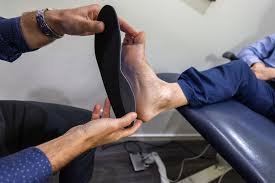Maintaining foot health can play a key role in overall well-being. Since feet carry and support the body’s weight during daily activities, the impact of incorrect or poorly designed footwear should not be underestimated. Concerns related to podiatry can begin or worsen due to improper footwear. Understanding the connection between footwear design and foot health can help individuals make informed decisions when selecting shoes.
How Shoes Can Affect Foot Structure
Shoes can influence the structure and alignment of feet. Poorly fitting or unsupportive footwear may lead to problems such as arch weakening, imbalanced pressure distribution, or toe misalignment. Flat footwear can cause strain on the plantar fascia, while high-heeled shoes put excessive pressure on the forefoot.
Over time, these stress points can contribute to common podiatry concerns, like plantar fasciitis, bunions, or metatarsalgia. To minimize issues, footwear should provide adequate arch support, cushioning, and snug heel grip. Selecting a design that promotes natural foot positioning may prevent unnecessary stress or strain.
Features of Footwear That Promote Foot Health
Certain features in footwear may provide specific benefits for foot health without introducing discomfort or strain. When evaluating shoes, it is helpful to look for the following characteristics:
- Quality materials that reduce friction and irritation, such as breathable fabrics or padded interiors.
- Appropriate toe-box space to avoid cramping while allowing natural movement of toes.
- Effective shock absorption through cushioned insoles or flexible midsoles designed to handle impact.
- Firm arch and heel support to stabilize feet during motion and enhance weight distribution.
- Traction-focused outsoles that prevent slipping and reduce unnecessary strain during movement.
Footwear Choices for Specific Needs
Podiatry professionals often note that footwear requirements can vary widely depending on individual foot health, lifestyle, and activity level. Walking shoes are designed with shock absorption in the heel and targeted support that benefits frequent walkers. Athletic shoes focus on providing flexibility and motion control for sports or running. Dress shoes may need slight modifications like cushioned inserts to counterbalance their typically stiffer soles. Those with specific conditions like plantar fasciitis or flat feet should consult with professionals in podiatry to determine which footwear options suit their unique physical needs. Orthotic inserts may also help when standard shoe designs are insufficient.
Long-Term Effects of Poor Footwear Choices
Wearing inappropriate shoes can have cascading effects on foot health and the musculoskeletal system over time. Persistent foot pain, overuse injuries, and alignment concerns such as hammertoes or Achilles tendon discomfort may stem from improper footwear. These issues can affect mobility, posture, and overall physical activity levels. Attending to footwear selection serves as a proactive approach to lowering the likelihood of developing these complications. Regularly inspecting worn-out shoes and replacing them when their structural support diminishes can also contribute to maintaining foot health.
Take the First Step With a Podiatry Professional
Footwear can play an integral role in shaping physical well-being. From influencing foot structure to preventing injuries, selecting supportive, well-designed shoes aligns with good podiatry practices. If you’re uncertain about your current footwear or experience ongoing foot discomfort, it may be the right time to consult with a podiatry professional to assess your needs and explore solutions.
- TimesHealthMag Fitness Workouts For Women – Burn Fat & Build Strength!
- Exploring the Essential Tools Behind Today’s Advanced Dental Procedures
- How To Choose the Right Gastroenterologist for Your Needs
- Exploring the Role of Stem Cell Injections in Regenerative Medicine
- Exercises to Relieve Elbow Pain and Improve Flexibility


Leave a Reply